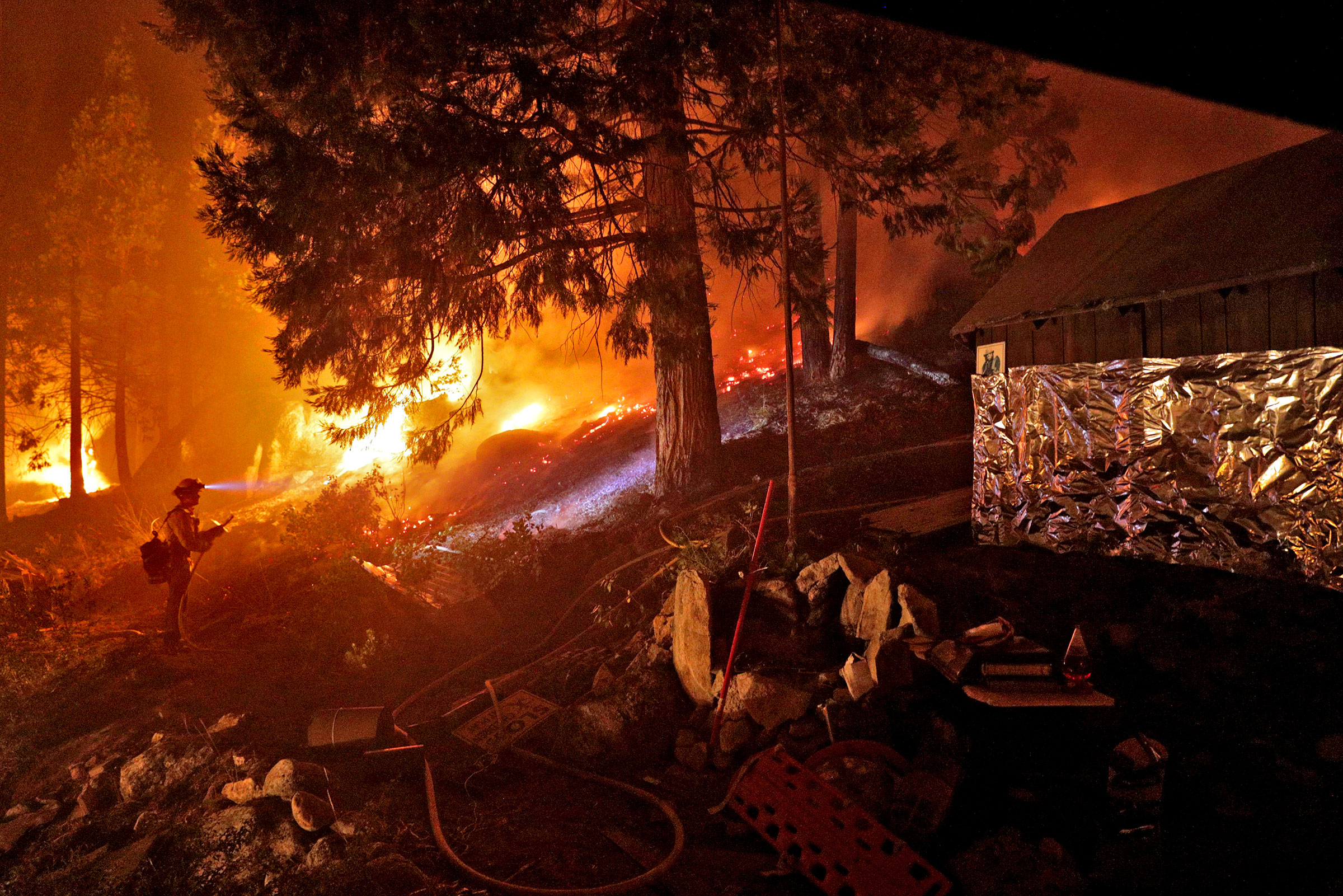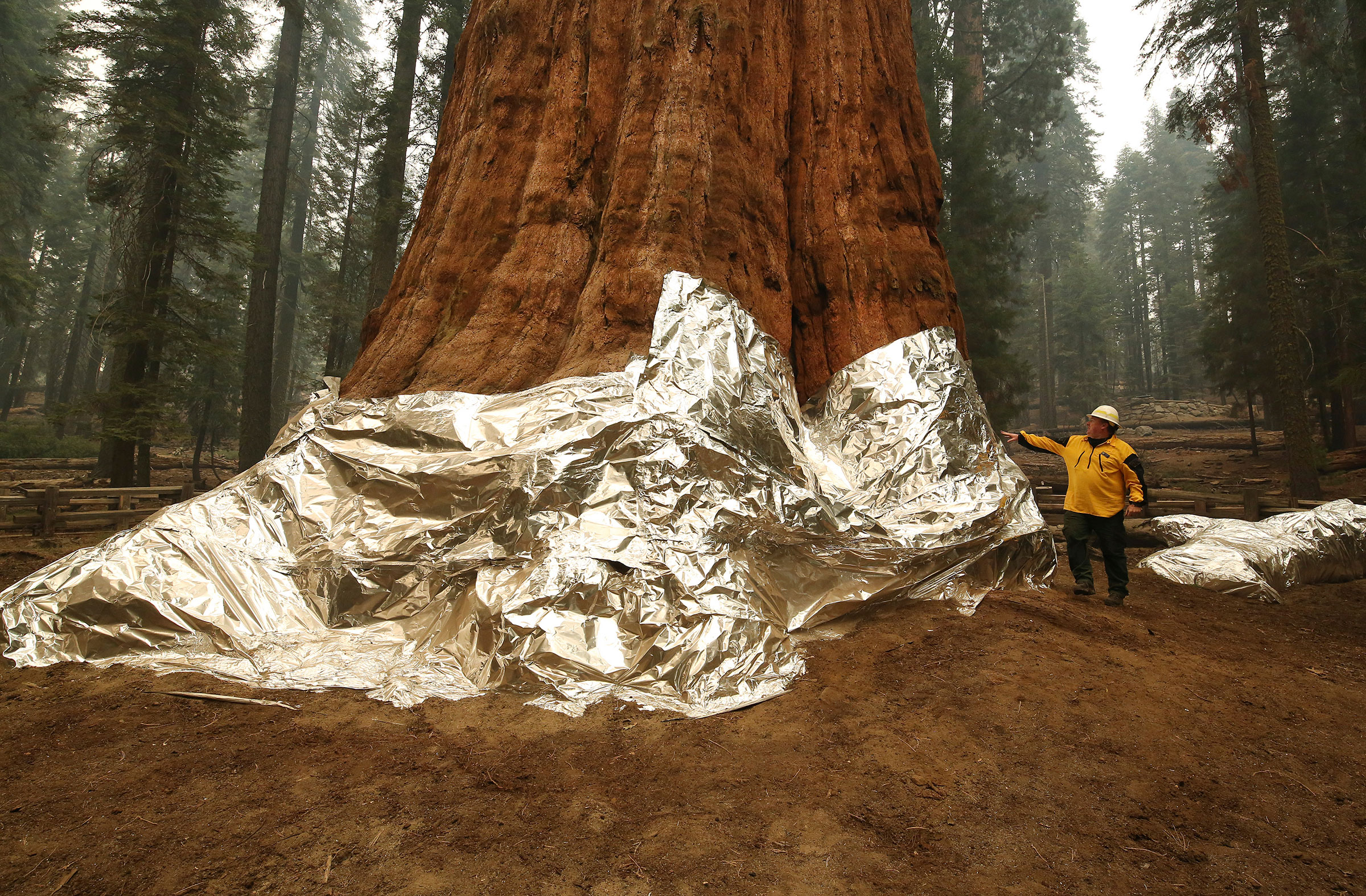
The photo made a splash on social media: General Sherman, the majestic 2,000-year-old Californian sequoia tree with a 36-foot circumference, its craggy trunk shining with silvery aluminum foil wrapped all around it to protect from potential wildfires. Like a baked potato in the oven, commenters said.
California-based Firezat, which is currently the only company in the U.S. that sells this aluminum wrap to public and private entities at scale, has sold thousands of square feet of the material for the express purpose of structural protection against wildfires—including the piece lovingly wrapped around General Sherman. Firezat’s sales increased 30% each of the last two years as fires become increasingly prominent threats to large swathes of both public and private land, with higher temperature, higher wind speeds and longer fire seasons straining firefighting capabilities, says Firezat CEO and founder Daniel Hirning. Five years ago, about 95% of the company’s business was in sales to forest service and Bureau of Land Management customers to protect things like historic buildings; that has expanded to include private homeowners. Hirning says about “several thousand” homes would be able to deploy Firezat by now, based on cumulative sales. Now, other businesses in the space are beginning to see the potential, too. But the buy-in for aluminum wraps, which block 96% of radiant heat, is just in the nascent stages, suggests Hirning. “You think all this coverage and all this advertising exposure [would increase sales even more], but it kind of has the opposite effect,” he says. “There’s an apathy. I think people just get overwhelmed.”

The aluminum wrap is an alternative to other go-to fireproofing methods, including fire-resistant gels and foams and water-saturation systems, that homeowners and forest service workers can use to protect structures. Priced at $680 per 1000-square-foot roll, Firezat’s option is a decently cost-effective investment in preventing a total disaster; an average single story home will require about three to four rolls of the stuff, Hirning says, and can be put up in about five or six hours. (It can also be stored and reused annually, and the average time to install the protection should decrease with practice.) A video on the website shows a foil-wrapped log cabin consumed in flames, only to emerge on the other side unscathed, surrounded by trees that look like blackened toothpicks. It’s an impressive case study.
Read More: The World Has Been On Fire for the Past Month. Here’s What It Looks Like
But the effort of wrapping up a house with Firezat ultimately lies with the end user. That’s where the start-up FireGuard hopes to play a role. Founded by civil and hydraulic engineer Shahriar Eftekharzadeh as a subsidiary of SEITec Inc., a science-based company that provides solutions for climate-change-based challenges, FireGuard is mostly a conceptual business right now. Eftekharzadeh’s vision is twofold: for preexisting buildings, his patent-pending “aluminized fiberglass fabric” would descend like protective curtains from a house’s eaves, enveloping the structure within about ten minutes. For new construction, it could be installed as a layer in exterior walls. Both options minimize the need for manual labor—and prioritize time—in the face of imminent fire. “You would know your house is equipped with a fire fighting system, the same as you’d have sprinklers for internal fires,” he says.
For his own cabin in the California woods, Eftekharzadeh has put in place the descending-curtain prototype; luckily, he’s never needed to use it. But it’s the only current example of the brand’s product in action. FireGuard launched a year ago, and has yet to become a priority in marketing; Eftekharzadeh’s primary projects include stormwater-recapture programs and compressed-air energy storage. Still, he sees it as a potentially game-changing option for homeowners—and firefighters. “The other thing we have in mind is that if you make a registry of houses that have this system, then that will really ease the burden on firefighters,” he says.
At other companies that sell aluminum-based radiant barriers commonly used for home insulation, like Texas-based Attic Foil and Innovative Insulation, it’s hard to gauge if the wildfire applications of aluminum wrapping technology have made much of a dent in sales so far, although Attic Foil CEO Ed Fritz did note a recent increase in sales to Californians in particular. But representatives from both confirmed that their materials could be useful in the face of fire—and at Innovative Insulation, their metalized cloth “Temptrol” fabric has even already been used in fire suits.
Read More: The Fight For Earth
As with any consumer product, none of these are 100% effective, says Seth Martin, assistant fire chief and fire marshal for the city of Ketchum, ID. Martin, a longtime firefighter, has plenty of experience wrapping things like forest service lookouts and even campground port-a-potties. It’s labor intensive, he cautions, and needs to be done with precision. “It takes a lot of time and manpower to actually wrap up a structure to the point where you’re fairly confident that it won’t burn,” he says. It can be extremely effective at deflecting heat and keeping embers at bay. But it’s not his go-to suggestion. “The better alternatives are taking mitigation measures ahead of time, and following the defensible space guidelines,” he says. Those include keeping the area around the house clear of potential fire fuel, and landscaping with an eye on fire safety. And those methods are free. “Prepare your house far ahead. Not days, but months, years. You have to start taking steps now to protect your home, before fire threatens,” he says.
As climate change escalates, drought worsens and public resources remain limited, however, sales for Firezat and other startups in the climate damage prevention space keep going up.
More Must-Reads From TIME
- The 100 Most Influential People of 2024
- The Revolution of Yulia Navalnaya
- 6 Compliments That Land Every Time
- What's the Deal With the Bitcoin Halving?
- If You're Dating Right Now , You're Brave: Column
- The AI That Could Heal a Divided Internet
- Fallout Is a Brilliant Model for the Future of Video Game Adaptations
- Want Weekly Recs on What to Watch, Read, and More? Sign Up for Worth Your Time
Write to Raisa Bruner at raisa.bruner@time.com